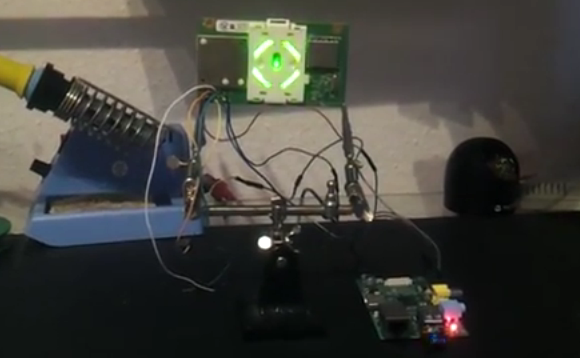
If you want to mess around with your Xbox 360 controllers on a computer Microsoft would be happy to sell you a USB dongle to do so. But [Tino] went a different route. The board that drives the Xbox 360’s status light ring also includes the RF module that wirelessly connects the controllers. He wired this up to his Raspberry Pi using the GPIO header.
The module connects via an internal cable and is treated much like a USB device by the Xbox motherboard. The problem is that it won’t actually handle the 5V rail found on a USB connector; it wants 3.3V. But this is no problem for the RPi’s pin header. Once a few connections have been made the lights are controlled via SPI I2C and [Tino] posted some example code up on Github to work with the RF module. He plans to post a follow-up that interfaces the module with a simple microcontroller rather than an RPi board. If you can’t wait for that we’re sure you can figure out the details you need by digging through his example code.















Already done, long time ago:
http://www.youtube.com/watch?feature=player_embedded&v=kCz2UY2oit4
After all these years I’m still tethered to my 360 by a light gray wire, so I don’t have this issue; been using my 360 controller with a PC for years. Of course, I don’t have the wonderful freedom that wireless gives you, so I’m still jealous. Nice hack.
Just a quickie; I find no reference anywhere on his page to SPI. He appears to
be saying that the LED functionality is controller over I2C.
As usual the writer can’t even transfer the correct information, surprised anyone would buy this site, and sit back and let this stuff happen
Sick of complaining about it. Just gets ignored every-single-time! Highly unprofessional.
I welcome our new spell-check using Overlords!
And they wanted to buy the freaking thing… with our money!
As much as I like this site, the inaccuracies in the writeups are really starting to take the piss now.
Hacking is about DETAILS and this site can’t even get that right!
Light right, or ring?
Really, even worse proof reading than before?
WTF…
I thought they were talking about a lite-brite at first!
As for USB @ 3.3v, it’s hardly surprising that it would be 5v tolerant given that it’s the most common thing. Not that I have a xbox360 nor that I looked at its design.
Given the COO of the light ring, I would think that it’s pronounced “Ring of Right” to the locals…
BOoOo!!
>The problem is that it won’t actually handle the 5V rail found on a USB connector; it wants 3.3V.
Wrong. I wired mine from my old 360 directly to a USB plug and it’s worked perfectly for seven months now.
Maybe a different hardware revision?
What drivers did you use? Did you use the ones for retail RF to USB controller adapters?
I used the one for Microsoft’s wireless xbox controller receiver.
I know that the device wants 3.3 but does that explicitly mean it won’t like 5v?
I’ve had plenty of devices that will *play nice* with voltages a little out of their range with no problems.
I”ve also read that what we would expect to be using standardised power systems in the 360 sometimes does not (kinect). Perhaps something similar could be true of this part too?
Dear HaD, please implement some sort of community-sourced proofreading system, since your authors are quite clearly borderline illiterate.
Err, this was done connecting it to a PC before the Raspberry Pi even came out… http://diru.org/wordpress/2011/03/wireless-xbox360-controller-on-a-pc-without-the-commercial-dongle/
Can it simulate the 3/4 circle of death?
Hey there,
“3V3 or 5V”:
Well, i could’t find any prof that the module is 5V tolerant. i didn’t even tried it with 5V. So unless i’m 100% sure that every rev of this unit would run with 5V i can’t write it into my article. ;)
“Someone did that before!”:
Yes, and i give some credits and a bit thanks to the original author (dilu) on the bottom of my article :)
“your english is eeewww!”:
And you are fully right with that. i come from germany and i didn’t had any extended english course or something similar. it becomes better, but it is still terrible ^^. Sorry about that. i could only write in german because of that, but then it would be useless for people that don’t speak german (and i even provide a full german version of this article). I personally think that you can understand what i’m doing there. If you want to improve the spelling or my english skills in general than write me an email and describe the errors i’ve made so i can correct it. (t.goehlert[at]googlemail.com)
“SPI??”
Yeah, mistakes happen from time to time ^^. i don’t think you would find anybody in gotham city who would say “aaarrgh, i can’t use it because it uses I2C instead of SPI” :D
<3
The corporation-symptoms are already visible, based on the complaints I see more and more often now compared to before hed HaD purchase Lol.
it will be interesting to see if the peoples voice has any effects, or
if it will be ignore like it usually is.
They showed a similar project around a year ago using an arduino uno and a voltage regulator. So I built my own using a $25 arduino fio and hooked to the arduinos built in 3.3v out. Its still working today.